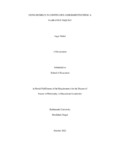
Please use this identifier to cite or link to this item:
https://hdl.handle.net/20.500.14301/151| Title: | USING RUBRICS IN CONTINUOUS ASSESSMENTSYSTEM: A NARRATIVE INQUIRY |
| Authors: | Dahal, Sagar |
| Citation: | Dahal,S.(2022)Using rubrics in continuous assessment system (CAS): A narrative inquiry. |
| Issue Date: | Oct-2022 |
| Publisher: | Kathmandu University School of Education |
| Department: | DOEL |
| Level: | M.Phil. |
| Program: | MPhil in Educational Leadership |
| Abstract: | My study explored the experiences of teachers' perceptions of using rubrics in a Continuous Assessment System (CAS). With a key research question, how do teachers narrate their experiences of using rubrics in CAS for evaluation? I commenced academic research, using narrative inquiry and applying social constructivism’s theory, covering three different schools. Altogether, three teachers one from public schools and two from private schools having mathematics, social studies, and English backgrounds were interviewed to collect their opinions and practices on using rubrics in CAS in their schools in Kathmandu Metropolitan city. This study is a qualitative research method where participants’ information was collected through narrative guidelines. The insight obtained from this research exposes teachers’ experiences that rubrics had played a role in being interactive authentic documents in the evaluation process, uniformity tools for evaluation in a systematic rule with minimum biases in evaluation. As a result, the research's findings help stakeholders realize the advantages of employing rubrics in teaching and learning, which enriches our ongoing educational ii practices. Additionally, this study will add to the body of knowledge since it is fresh and original and because it was carried out in an environment where there is little research on instructors' impressions of the use of rubrics in CAS. Finally, it is expected that the novel narratives this journey may awaken in the field of education will break the rigidity of conventions associated with the traditional practices of summative tests. It allows educators about think the direction for any needful changes to the current practice that will ultimately benefit student learning that I believe is possible. |
| URI: | https://hdl.handle.net/20.500.14301/151 |
| Appears in Collections: | Dissertation |
Files in This Item:
| File | Description | Size | Format | |
|---|---|---|---|---|
| Sagar Dahal MPhil 20790728.pdf | 1.85 MB | Adobe PDF |  View/Open |
Items in DSpace are protected by copyright, with all rights reserved, unless otherwise indicated.